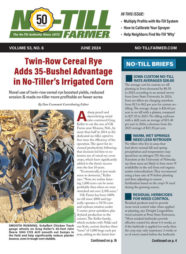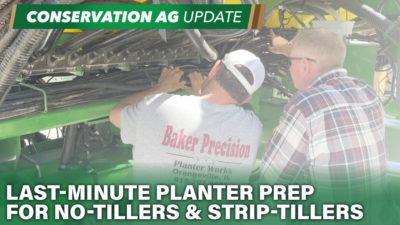By Adam Varenhorst, Extension Field Crop Entomologist
Large grasshopper populations have been observed in Central South Dakota. These populations have required management in other crops and should be monitored prior to and during winter wheat planting. Most observations have been of two-striped grasshoppers (Figure 1), but it is likely that other species are present as well (Figure 2 and Figure 3).
The increased grasshopper population is likely due to abundant food sources during 2019. As the season progresses, there will be reduced food availability due to crop senescence and the currently dry conditions. These factors will force the grasshoppers to seek green plants, such as newly emerged wheat plants.
It is important to scout emerging winter wheat for grasshoppers and feeding injury, especially in areas where large populations are being observed. Newly emerging winter wheat is a very attractive host to grasshoppers.
Grasshoppers can cause stand loss by clipping back the emerging plants. This type of injury will be more noticeable along the field margins, as grasshoppers reside in the nearby vegetation.
To minimize the impact of grasshoppers on emerging winter wheat, it is important to monitor fields and determine grasshopper densities before and after planting.
Grasshopper Management Options
Prior to Planting
Before planting, scout the vegetation around the field edges and count the number of grasshoppers that are present in approximately one square yard. Management should be considered if 11-20 grasshoppers per square yard are present in the non-crop borders. Here are a few management options to consider:
- Delay planting in areas where grasshopper populations are high to reduce the time that grasshoppers will be feeding on the emerging wheat.
- When there are increased grasshopper population densities in areas surrounding the field, double the planting population for a strip that is between 60-120 feet wide around the field edge. As grasshoppers move into the field they will feed on the emerging wheat. However, the increased plant stands around the edge will slow the movement of the grasshoppers into the rest of the field. The increased plant stand will compensate for the lost seedlings and allow for a reasonable stand to exist after grasshoppers have finished foraging for the year.
- Insecticide seed treatments are labeled for grasshopper management in winter wheat and can provide protection during emergence. For grasshoppers, treated seed can be planted along field edges in a strip that is 60-120 feet wide, or it can be planted to the entire field. For effective management of grasshoppers, the highest registered rate of the product should be applied to the seed. Please refer to latest South Dakota Pest Management Guide: Wheat for insecticide seed treatment options and recommended rates.
- Foliar insecticide sprays may be applied to the non-crop field edges to prevent the grasshoppers from moving into the wheat fields. Before selecting an insecticide, check the label to ensure that it can be sprayed on non-crop areas. See Table 1 for a list of non-crop and pasture insecticide options.






Post a comment
Report Abusive Comment